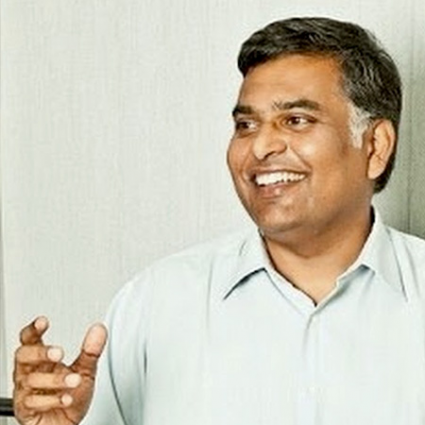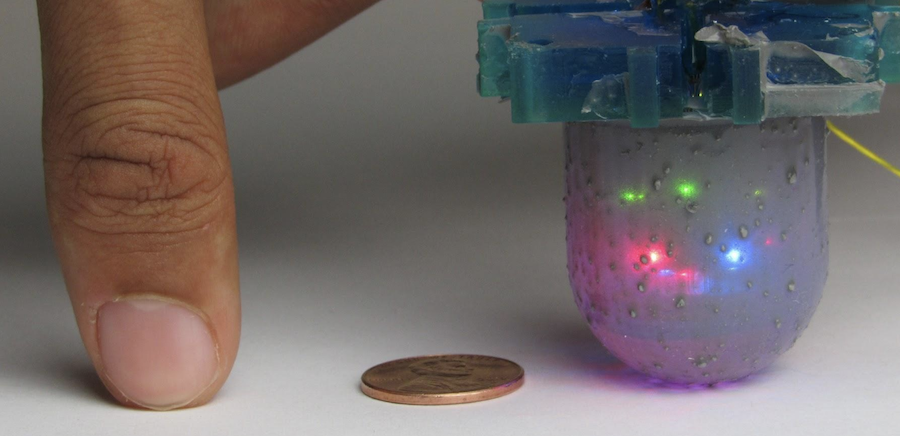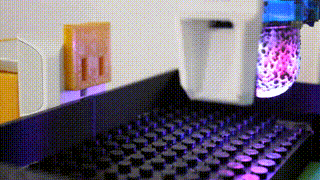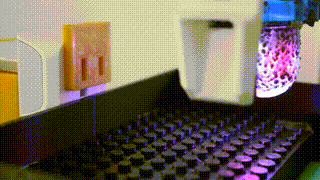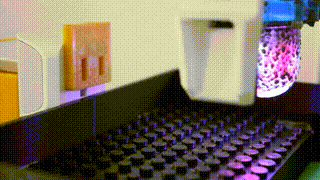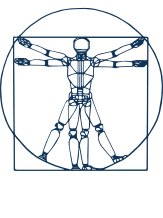| Paper ID |
Title |
Authors |
Virtual Session Link |
| 1 |
Planning and Execution using Inaccurate Models with Provable Guarantees |
Anirudh Vemula (Carnegie Mellon University)*; Yash Oza (CMU); J. Bagnell (Aurora Innovation); Maxim Likhachev (CMU) |
Virtual Session #1 |
| 2 |
Swoosh! Rattle! Thump! – Actions that Sound |
Dhiraj Gandhi (Carnegie Mellon University)*; Abhinav Gupta (Carnegie Mellon University); Lerrel Pinto (NYU/Berkeley) |
Virtual Session #1 |
| 3 |
Deep Visual Reasoning: Learning to Predict Action Sequences for Task and Motion Planning from an Initial Scene Image |
Danny Driess (Machine Learning and Robotics Lab, University of Stuttgart)*; Jung-Su Ha (); Marc Toussaint () |
Virtual Session #1 |
| 4 |
Elaborating on Learned Demonstrations with Temporal Logic Specifications |
Craig Innes (University of Edinburgh)*; Subramanian Ramamoorthy (University of Edinburgh) |
Virtual Session #1 |
| 5 |
Non-revisiting Coverage Task with Minimal Discontinuities for Non-redundant Manipulators |
Tong Yang (Zhejiang University)*; Jaime Valls Miro (University of Technology Sydney); Yue Wang (Zhejiang University); Rong Xiong (Zhejiang University) |
Virtual Session #1 |
| 6 |
LatticeNet: Fast Point Cloud Segmentation Using Permutohedral Lattices |
Radu Alexandru Rosu (University of Bonn)*; Peer Schütt (University of Bonn); Jan Quenzel (University of Bonn); Sven Behnke (University of Bonn) |
Virtual Session #1 |
| 7 |
A Smooth Representation of Belief over SO(3) for Deep Rotation Learning with Uncertainty |
Valentin Peretroukhin (University of Toronto)*; Matthew Giamou (University of Toronto); W. Nicholas Greene (MIT); David Rosen (MIT Laboratory for Information and Decision Systems); Jonathan Kelly (University of Toronto); Nicholas Roy (MIT) |
Virtual Session #1 |
| 8 |
Leading Multi-Agent Teams to Multiple Goals While Maintaining Communication |
Brian Reily (Colorado School of Mines)*; Christopher Reardon (ARL); Hao Zhang (Colorado School of Mines) |
Virtual Session #1 |
| 9 |
OverlapNet: Loop Closing for LiDAR-based SLAM |
Xieyuanli Chen (Photogrammetry & Robotics Lab, University of Bonn)*; Thomas Läbe (Institute for Geodesy and Geoinformation, University of Bonn); Andres Milioto (University of Bonn); Timo Röhling (Fraunhofer FKIE); Olga Vysotska (Autonomous Intelligent Driving GmbH); Alexandre Haag (AID); Jens Behley (University of Bonn); Cyrill Stachniss (University of Bonn) |
Virtual Session #1 |
| 10 |
The Dark Side of Embodiment – Teaming Up With Robots VS Disembodied Agents |
Filipa Correia (INESC-ID & University of Lisbon)*; Samuel Gomes (IST/INESC-ID); Samuel Mascarenhas (INESC-ID); Francisco S. Melo (IST/INESC-ID); Ana Paiva (INESC-ID U of Lisbon) |
Virtual Session #1 |
| 11 |
Shared Autonomy with Learned Latent Actions |
Hong Jun Jeon (Stanford University)*; Dylan Losey (Stanford University); Dorsa Sadigh (Stanford) |
Virtual Session #1 |
| 12 |
Regularized Graph Matching for Correspondence Identification under Uncertainty in Collaborative Perception |
Peng Gao (Colorado school of mines)*; Rui Guo (Toyota Motor North America); Hongsheng Lu (Toyota Motor North America); Hao Zhang (Colorado School of Mines) |
Virtual Session #1 |
| 13 |
Frequency Modulation of Body Waves to Improve Performance of Limbless Robots |
Baxi Zhong (Goergia Tech)*; Tianyu Wang (Carnegie Mellon University); Jennifer Rieser (Georgia Institute of Technology); Abdul Kaba (Morehouse College); Howie Choset (Carnegie Melon University); Daniel Goldman (Georgia Institute of Technology) |
Virtual Session #1 |
| 14 |
Self-Reconfiguration in Two-Dimensions via Active Subtraction with Modular Robots |
Matthew Hall (The University of Sheffield)*; Anil Ozdemir (The University of Sheffield); Roderich Gross (The University of Sheffield) |
Virtual Session #1 |
| 15 |
Singularity Maps of Space Robots and their Application to Gradient-based Trajectory Planning |
Davide Calzolari (Technical University of Munich (TUM), German Aerospace Center (DLR))*; Roberto Lampariello (German Aerospace Center); Alessandro Massimo Giordano (Deutches Zentrum für Luft und Raumfahrt) |
Virtual Session #1 |
| 16 |
Grounding Language to Non-Markovian Tasks with No Supervision of Task Specifications |
Roma Patel (Brown University)*; Ellie Pavlick (Brown University); Stefanie Tellex (Brown University) |
Virtual Session #1 |
| 17 |
Fast Uniform Dispersion of a Crash-prone Swarm |
Michael Amir (Technion – Israel Institute of Technology)*; Freddy Bruckstein (Technion) |
Virtual Session #1 |
| 18 |
Simultaneous Enhancement and Super-Resolution of Underwater Imagery for Improved Visual Perception |
Md Jahidul Islam (University of Minnesota Twin Cities)*; Peigen Luo (University of Minnesota-Twin Cities); Junaed Sattar (University of Minnesota) |
Virtual Session #1 |
| 19 |
Collision Probabilities for Continuous-Time Systems Without Sampling |
Kristoffer Frey (MIT)*; Ted Steiner (Charles Stark Draper Laboratory, Inc.); Jonathan How (MIT) |
Virtual Session #1 |
| 20 |
Event-Driven Visual-Tactile Sensing and Learning for Robots |
Tasbolat Taunyazov (National University of Singapore); Weicong Sng (National University of Singapore); Brian Lim (National University of Singapore); Hian Hian See (National University of Singapore); Jethro Kuan (National University of Singapore); Abdul Fatir Ansari (National University of Singapore); Benjamin Tee (National University of Singapore); Harold Soh (National University Singapore)* |
Virtual Session #1 |
| 21 |
Resilient Distributed Diffusion for Multi-Robot Systems Using Centerpoint |
JIANI LI (Vanderbilt University)*; Waseem Abbas (Vanderbilt University); Mudassir Shabbir (Information Technology University); Xenofon Koutsoukos (Vanderbilt University) |
Virtual Session #1 |
| 22 |
Pixel-Wise Motion Deblurring of Thermal Videos |
Manikandasriram Srinivasan Ramanagopal (University of Michigan)*; Zixu Zhang (University of Michigan); Ram Vasudevan (University of Michigan); Matthew Johnson Roberson (University of Michigan) |
Virtual Session #1 |
| 23 |
Controlling Contact-Rich Manipulation Under Partial Observability |
Florian Wirnshofer (Siemens AG)*; Philipp Sebastian Schmitt (Siemens AG); Georg von Wichert (Siemens AG); Wolfram Burgard (University of Freiburg) |
Virtual Session #1 |
| 24 |
AVID: Learning Multi-Stage Tasks via Pixel-Level Translation of Human Videos |
Laura Smith (UC Berkeley)*; Nikita Dhawan (UC Berkeley); Marvin Zhang (UC Berkeley); Pieter Abbeel (UC Berkeley); Sergey Levine (UC Berkeley) |
Virtual Session #1 |
| 25 |
Provably Constant-time Planning and Re-planning for Real-time Grasping Objects off a Conveyor Belt |
Fahad Islam (Carnegie Mellon University)*; Oren Salzman (Technion); Aditya Agarwal (CMU); Likhachev Maxim (Carnegie Mellon University) |
Virtual Session #1 |
| 26 |
Online IMU Intrinsic Calibration: Is It Necessary? |
Yulin Yang (University of Delaware)*; Patrick Geneva (University of Delaware); Xingxing Zuo (Zhejiang University); Guoquan Huang (University of Delaware) |
Virtual Session #1 |
| 27 |
A Berry Picking Robot With A Hybrid Soft-Rigid Arm: Design and Task Space Control |
Naveen Kumar Uppalapati (University of Illinois at Urbana Champaign)*; Benjamin Walt ( University of Illinois at Urbana Champaign); Aaron Havens (University of Illinois Urbana Champaign); Armeen Mahdian (University of Illinois at Urbana Champaign); Girish Chowdhary (University of Illinois at Urbana Champaign); Girish Krishnan (University of Illinois at Urbana Champaign) |
Virtual Session #1 |
| 28 |
Iterative Repair of Social Robot Programs from Implicit User Feedback via Bayesian Inference |
Michael Jae-Yoon Chung (University of Washington)*; Maya Cakmak (University of Washington) |
Virtual Session #1 |
| 29 |
Cable Manipulation with a Tactile-Reactive Gripper |
Siyuan Dong (MIT); Shaoxiong Wang (MIT); Yu She (MIT)*; Neha Sunil (Massachusetts Institute of Technology); Alberto Rodriguez (MIT); Edward Adelson (MIT, USA) |
Virtual Session #1 |
| 30 |
Automated Synthesis of Modular Manipulators’ Structure and Control for Continuous Tasks around Obstacles |
Thais Campos de Almeida (Cornell University)*; Samhita Marri (Cornell University); Hadas Kress-Gazit (Cornell) |
Virtual Session #1 |
| 31 |
Learning Memory-Based Control for Human-Scale Bipedal Locomotion |
Jonah Siekmann (Oregon State University)*; Srikar Valluri (Oregon State University); Jeremy Dao (Oregon State University); Francis Bermillo (Oregon State University); Helei Duan (Oregon State University); Alan Fern (Oregon State University); Jonathan Hurst (Oregon State University) |
Virtual Session #1 |
| 32 |
Multi-Fidelity Black-Box Optimization for Time-Optimal Quadrotor Maneuvers |
Gilhyun Ryou (Massachusetts Institute of Technology)*; Ezra Tal (Massachusetts Institute of Technology); Sertac Karaman (Massachusetts Institute of Technology) |
Virtual Session #1 |
| 33 |
Manipulation Trajectory Optimization with Online Grasp Synthesis and Selection |
Lirui Wang (University of Washington)*; Yu Xiang (NVIDIA); Dieter Fox (NVIDIA Research / University of Washington) |
Virtual Session #1 |
| 34 |
VisuoSpatial Foresight for Multi-Step, Multi-Task Fabric Manipulation |
Ryan Hoque (UC Berkeley)*; Daniel Seita (University of California, Berkeley); Ashwin Balakrishna (UC Berkeley); Aditya Ganapathi (University of California, Berkeley); Ajay Tanwani (UC Berkeley); Nawid Jamali (Honda Research Institute); Katsu Yamane (Honda Research Institute); Soshi Iba (Honda Research Institute); Ken Goldberg (UC Berkeley) |
Virtual Session #1 |
| 35 |
Spatial Action Maps for Mobile Manipulation |
Jimmy Wu (Princeton University)*; Xingyuan Sun (Princeton University); Andy Zeng (Google); Shuran Song (Columbia University); Johnny Lee (Google); Szymon Rusinkiewicz (Princeton University); Thomas Funkhouser (Princeton University) |
Virtual Session #2 |
| 36 |
Generalized Tsallis Entropy Reinforcement Learning and Its Application to Soft Mobile Robots |
Kyungjae Lee (Seoul National University)*; Sungyub Kim (KAIST); Sungbin Lim (UNIST); Sungjoon Choi (Disney Research); Mineui Hong (Seoul National University); Jaein Kim (Seoul National University); Yong-Lae Park (Seoul National University); Songhwai Oh (Seoul National University) |
Virtual Session #2 |
| 37 |
Learning Labeled Robot Affordance Models Using Simulations and Crowdsourcing |
Adam Allevato (UT Austin)*; Elaine Short (Tufts University); Mitch Pryor (UT Austin); Andrea Thomaz (UT Austin) |
Virtual Session #2 |
| 38 |
Towards Embodied Scene Description |
Sinan Tan (Tsinghua University); Huaping Liu (Tsinghua University)*; Di Guo (Tsinghua University); Xinyu Zhang (Tsinghua University); Fuchun Sun (Tsinghua University) |
Virtual Session #2 |
| 39 |
Reinforcement Learning based Control of Imitative Policies for Near-Accident Driving |
Zhangjie Cao (Stanford University); Erdem Biyik (Stanford University)*; Woodrow Wang (Stanford University); Allan Raventos (Toyota Research Institute); Adrien Gaidon (Toyota Research Institute); Guy Rosman (Toyota Research Institute); Dorsa Sadigh (Stanford) |
Virtual Session #2 |
| 40 |
Deep Drone Acrobatics |
Elia Kaufmann (ETH / University of Zurich)*; Antonio Loquercio (ETH / University of Zurich); Rene Ranftl (Intel Labs); Matthias Müller (Intel Labs); Vladlen Koltun (Intel Labs); Davide Scaramuzza (University of Zurich & ETH Zurich, Switzerland) |
Virtual Session #2 |
| 41 |
Active Preference-Based Gaussian Process Regression for Reward Learning |
Erdem Biyik (Stanford University)*; Nicolas Huynh (École Polytechnique); Mykel Kochenderfer (Stanford University); Dorsa Sadigh (Stanford) |
Virtual Session #2 |
| 42 |
A Bayesian Framework for Nash Equilibrium Inference in Human-Robot Parallel Play |
Shray Bansal (Georgia Institute of Technology)*; Jin Xu (Georgia Institute of Technology); Ayanna Howard (Georgia Institute of Technology); Charles Isbell (Georgia Institute of Technology) |
Virtual Session #2 |
| 43 |
Data-driven modeling of a flapping bat robot with a single flexible wing surface |
Jonathan Hoff (University of Illinois at Urbana-Champaign)*; Seth Hutchinson (Georgia Tech) |
Virtual Session #2 |
| 44 |
Safe Motion Planning for Autonomous Driving using an Adversarial Road Model |
Alex Liniger (ETH Zurich)*; Luc Van Gool (ETH Zurich) |
Virtual Session #2 |
| 45 |
A Motion Taxonomy for Manipulation Embedding |
David Paulius (University of South Florida)*; Nicholas Eales (University of South Florida); Yu Sun (University of South Florida) |
Virtual Session #2 |
| 46 |
Aerial Manipulation Using Hybrid Force and Position NMPC Applied to Aerial Writing |
Dimos Tzoumanikas (Imperial College London)*; Felix Graule (ETH Zurich); Qingyue Yan (Imperial College London); Dhruv Shah (Berkeley Artificial Intelligence Research); Marija Popovic (Imperial College London); Stefan Leutenegger (Imperial College London) |
Virtual Session #2 |
| 47 |
A Global Quasi-Dynamic Model for Contact-Trajectory Optimization in Manipulation |
Bernardo Aceituno-Cabezas (MIT)*; Alberto Rodriguez (MIT) |
Virtual Session #2 |
| 48 |
Vision-Based Goal-Conditioned Policies for Underwater Navigation in the Presence of Obstacles |
Travis Manderson (McGill University)*; Juan Camilo Gamboa Higuera (McGill University); Stefan Wapnick (McGill University); Jean-François Tremblay (McGill University); Florian Shkurti (University of Toronto); David Meger (McGill University); Gregory Dudek (McGill University) |
Virtual Session #2 |
| 49 |
Spatio-Temporal Stochastic Optimization: Theory and Applications to Optimal Control and Co-Design |
Ethan Evans (Georgia Institute of Technology)*; Andrew Kendall (Georgia Institute of Technology); Georgios Boutselis (Georgia Institute of Technology ); Evangelos Theodorou (Georgia Institute of Technology) |
Virtual Session #2 |
| 50 |
Kernel Taylor-Based Value Function Approximation for Continuous-State Markov Decision Processes |
Junhong Xu (INDIANA UNIVERSITY)*; Kai Yin (Vrbo, Expedia Group); Lantao Liu (Indiana University, Intelligent Systems Engineering) |
Virtual Session #2 |
| 51 |
HMPO: Human Motion Prediction in Occluded Environments for Safe Motion Planning |
Jaesung Park (University of North Carolina at Chapel Hill)*; Dinesh Manocha (University of Maryland at College Park) |
Virtual Session #2 |
| 52 |
Motion Planning for Variable Topology Truss Modular Robot |
Chao Liu (University of Pennsylvania)*; Sencheng Yu (University of Pennsylvania); Mark Yim (University of Pennsylvania) |
Virtual Session #2 |
| 53 |
Emergent Real-World Robotic Skills via Unsupervised Off-Policy Reinforcement Learning |
Archit Sharma (Google)*; Michael Ahn (Google); Sergey Levine (Google); Vikash Kumar (Google); Karol Hausman (Google Brain); Shixiang Gu (Google Brain) |
Virtual Session #2 |
| 54 |
Compositional Transfer in Hierarchical Reinforcement Learning |
Markus Wulfmeier (DeepMind)*; Abbas Abdolmaleki (Google DeepMind); Roland Hafner (Google DeepMind); Jost Tobias Springenberg (DeepMind); Michael Neunert (Google DeepMind); Noah Siegel (DeepMind); Tim Hertweck (DeepMind); Thomas Lampe (DeepMind); Nicolas Heess (DeepMind); Martin Riedmiller (DeepMind) |
Virtual Session #2 |
| 55 |
Learning from Interventions: Human-robot interaction as both explicit and implicit feedback |
Jonathan Spencer (Princeton University)*; Sanjiban Choudhury (University of Washington); Matt Barnes (University of Washington); Matthew Schmittle (University of Washington); Mung Chiang (Princeton University); Peter Ramadge (Princeton); Siddhartha Srinivasa (University of Washington) |
Virtual Session #2 |
| 56 |
Fourier movement primitives: an approach for learning rhythmic robot skills from demonstrations |
Thibaut Kulak (Idiap Research Institute)*; Joao Silverio (Idiap Research Institute); Sylvain Calinon (Idiap Research Institute) |
Virtual Session #2 |
| 57 |
Self-Supervised Localisation between Range Sensors and Overhead Imagery |
Tim Tang (University of Oxford)*; Daniele De Martini (University of Oxford); Shangzhe Wu (University of Oxford); Paul Newman (University of Oxford) |
Virtual Session #2 |
| 58 |
Probabilistic Swarm Guidance Subject to Graph Temporal Logic Specifications |
Franck Djeumou (University of Texas at Austin)*; Zhe Xu (University of Texas at Austin); Ufuk Topcu (University of Texas at Austin) |
Virtual Session #2 |
| 59 |
In-Situ Learning from a Domain Expert for Real World Socially Assistive Robot Deployment |
Katie Winkle (Bristol Robotics Laboratory)*; Severin Lemaignan (); Praminda Caleb-Solly (); Paul Bremner (); Ailie Turton (University of the West of England); Ute Leonards () |
Virtual Session #2 |
| 60 |
MRFMap: Online Probabilistic 3D Mapping using Forward Ray Sensor Models |
Kumar Shaurya Shankar (Carnegie Mellon University)*; Nathan Michael (Carnegie Mellon University) |
Virtual Session #2 |
| 61 |
GTI: Learning to Generalize across Long-Horizon Tasks from Human Demonstrations |
Ajay Mandlekar (Stanford University); Danfei Xu (Stanford University)*; Roberto Martín-Martín (Stanford University); Silvio Savarese (Stanford University); Li Fei-Fei (Stanford University) |
Virtual Session #2 |
| 62 |
Agbots 2.0: Weeding Denser Fields with Fewer Robots |
Wyatt McAllister (University of Illinois)*; Joshua Whitman (University of Illinois); Allan Axelrod (University of Illinois); Joshua Varghese (University of Illinois); Girish Chowdhary (University of Illinois at Urbana Champaign); Adam Davis (University of Illinois) |
Virtual Session #2 |
| 63 |
Optimally Guarding Perimeters and Regions with Mobile Range Sensors |
Siwei Feng (Rutgers University)*; Jingjin Yu (Rutgers Univ.) |
Virtual Session #2 |
| 64 |
Learning Agile Robotic Locomotion Skills by Imitating Animals |
Xue Bin Peng (UC Berkeley)*; Erwin Coumans (Google); Tingnan Zhang (Google); Tsang-Wei Lee (Google Brain); Jie Tan (Google); Sergey Levine (UC Berkeley) |
Virtual Session #2 |
| 65 |
Learning to Manipulate Deformable Objects without Demonstrations |
Yilin Wu (UC Berkeley); Wilson Yan (UC Berkeley)*; Thanard Kurutach (UC Berkeley); Lerrel Pinto (); Pieter Abbeel (UC Berkeley) |
Virtual Session #2 |
| 66 |
Deep Differentiable Grasp Planner for High-DOF Grippers |
Min Liu (National University of Defense Technology)*; Zherong Pan (University of North Carolina at Chapel Hill); Kai Xu (National University of Defense Technology); Kanishka Ganguly (University of Maryland at College Park); Dinesh Manocha (University of North Carolina at Chapel Hill) |
Virtual Session #2 |
| 67 |
Ergodic Specifications for Flexible Swarm Control: From User Commands to Persistent Adaptation |
Ahalya Prabhakar (Northwestern University)*; Ian Abraham (Northwestern University); Annalisa Taylor (Northwestern University); Millicent Schlafly (Northwestern University); Katarina Popovic (Northwestern University); Giovani Diniz (Raytheon); Brendan Teich (Raytheon); Borislava Simidchieva (Raytheon); Shane Clark (Raytheon); Todd Murphey (Northwestern Univ.) |
Virtual Session #2 |
| 68 |
Dynamic Multi-Robot Task Allocation under Uncertainty and Temporal Constraints |
Shushman Choudhury (Stanford University)*; Jayesh Gupta (Stanford University); Mykel Kochenderfer (Stanford University); Dorsa Sadigh (Stanford); Jeannette Bohg (Stanford) |
Virtual Session #2 |
| 69 |
Latent Belief Space Motion Planning under Cost, Dynamics, and Intent Uncertainty |
Dicong Qiu (iSee); Yibiao Zhao (iSee); Chris Baker (iSee)* |
Virtual Session #2 |
| 70 |
Learning of Sub-optimal Gait Controllers for Magnetic Walking Soft Millirobots |
Utku Culha (Max-Planck Institute for Intelligent Systems); Sinan Ozgun Demir (Max Planck Institute for Intelligent Systems); Sebastian Trimpe (Max Planck Institute for Intelligent Systems); Metin Sitti (Carnegie Mellon University)* |
Virtual Session #3 |
| 71 |
Nonparametric Motion Retargeting for Humanoid Robots on Shared Latent Space |
Sungjoon Choi (Disney Research)*; Matthew Pan (Disney Research); Joohyung Kim (University of Illinois Urbana-Champaign) |
Virtual Session #3 |
| 72 |
Residual Policy Learning for Shared Autonomy |
Charles Schaff (Toyota Technological Institute at Chicago)*; Matthew Walter (Toyota Technological Institute at Chicago) |
Virtual Session #3 |
| 73 |
Efficient Parametric Multi-Fidelity Surface Mapping |
Aditya Dhawale (Carnegie Mellon University)*; Nathan Michael (Carnegie Mellon University) |
Virtual Session #3 |
| 74 |
Towards neuromorphic control: A spiking neural network based PID controller for UAV |
Rasmus Stagsted (University of Southern Denmark); Antonio Vitale (ETH Zurich); Jonas Binz (ETH Zurich); Alpha Renner (Institute of Neuroinformatics, University of Zurich and ETH Zurich); Leon Bonde Larsen (University of Southern Denmark); Yulia Sandamirskaya (Institute of Neuroinformatics, University of Zurich and ETH Zurich, Switzerland)* |
Virtual Session #3 |
| 75 |
Quantile QT-Opt for Risk-Aware Vision-Based Robotic Grasping |
Cristian Bodnar (University of Cambridge)*; Adrian Li (X); Karol Hausman (Google Brain); Peter Pastor (X); Mrinal Kalakrishnan (X) |
Virtual Session #3 |
| 76 |
Scaling data-driven robotics with reward sketching and batch reinforcement learning |
Serkan Cabi (DeepMind)*; Sergio Gómez Colmenarejo (DeepMind); Alexander Novikov (DeepMind); Ksenia Konyushova (DeepMind); Scott Reed (DeepMind); Rae Jeong (DeepMind); Konrad Zolna (DeepMind); Yusuf Aytar (DeepMind); David Budden (DeepMind); Mel Vecerik (Deepmind); Oleg Sushkov (DeepMind); David Barker (DeepMind); Jonathan Scholz (DeepMind); Misha Denil (DeepMind); Nando de Freitas (DeepMind); Ziyu Wang (Google Research, Brain Team) |
Virtual Session #3 |
| 77 |
MPTC – Modular Passive Tracking Controller for stack of tasks based control frameworks |
Johannes Englsberger (German Aerospace Center (DLR))*; Alexander Dietrich (DLR); George Mesesan (German Aerospace Center (DLR)); Gianluca Garofalo (German Aerospace Center (DLR)); Christian Ott (DLR); Alin Albu-Schaeffer (Robotics and Mechatronics Center (RMC), German Aerospace Center (DLR)) |
Virtual Session #3 |
| 78 |
NH-TTC: A gradient-based framework for generalized anticipatory collision avoidance |
Bobby Davis (University of Minnesota Twin Cities)*; Ioannis Karamouzas (Clemson University); Stephen Guy (University of Minnesota Twin Cities) |
Virtual Session #3 |
| 79 |
3D Dynamic Scene Graphs: Actionable Spatial Perception with Places, Objects, and Humans |
Antoni Rosinol (MIT)*; Arjun Gupta (MIT); Marcus Abate (MIT); Jingnan Shi (MIT); Luca Carlone (Massachusetts Institute of Technology) |
Virtual Session #3 |
| 80 |
Robot Object Retrieval with Contextual Natural Language Queries |
Thao Nguyen (Brown University)*; Nakul Gopalan (Georgia Tech); Roma Patel (Brown University); Matthew Corsaro (Brown University); Ellie Pavlick (Brown University); Stefanie Tellex (Brown University) |
Virtual Session #3 |
| 81 |
AlphaPilot: Autonomous Drone Racing |
Philipp Foehn (ETH / University of Zurich)*; Dario Brescianini (University of Zurich); Elia Kaufmann (ETH / University of Zurich); Titus Cieslewski (University of Zurich & ETH Zurich); Mathias Gehrig (University of Zurich); Manasi Muglikar (University of Zurich); Davide Scaramuzza (University of Zurich & ETH Zurich, Switzerland) |
Virtual Session #3 |
| 82 |
Concept2Robot: Learning Manipulation Concepts from Instructions and Human Demonstrations |
Lin Shao (Stanford University)*; Toki Migimatsu (Stanford University); Qiang Zhang (Shanghai Jiao Tong University); Kaiyuan Yang (Stanford University); Jeannette Bohg (Stanford) |
Virtual Session #3 |
| 83 |
A Variable Rolling SLIP Model for a Conceptual Leg Shape to Increase Robustness of Uncertain Velocity on Unknown Terrain |
Adar Gaathon (Technion – Israel Institute of Technology)*; Amir Degani (Technion – Israel Institute of Technology) |
Virtual Session #3 |
| 84 |
Interpreting and Predicting Tactile Signals via a Physics-Based and Data-Driven Framework |
Yashraj Narang (NVIDIA)*; Karl Van Wyk (NVIDIA); Arsalan Mousavian (NVIDIA); Dieter Fox (NVIDIA) |
Virtual Session #3 |
| 85 |
Learning Active Task-Oriented Exploration Policies for Bridging the Sim-to-Real Gap |
Jacky Liang (Carnegie Mellon University)*; Saumya Saxena (Carnegie Mellon University); Oliver Kroemer (Carnegie Mellon University) |
Virtual Session #3 |
| 86 |
Manipulation with Shared Grasping |
Yifan Hou (Carnegie Mellon University)*; Zhenzhong Jia (SUSTech); Matthew Mason (Carnegie Mellon University) |
Virtual Session #3 |
| 87 |
Deep Learning Tubes for Tube MPC |
David Fan (Georgia Institute of Technology )*; Ali Agha (Jet Propulsion Laboratory); Evangelos Theodorou (Georgia Institute of Technology) |
Virtual Session #3 |
| 88 |
Reinforcement Learning for Safety-Critical Control under Model Uncertainty, using Control Lyapunov Functions and Control Barrier Functions |
Jason Choi (UC Berkeley); Fernando Castañeda (UC Berkeley); Claire Tomlin (UC Berkeley); Koushil Sreenath (Berkeley)* |
Virtual Session #3 |
| 89 |
Fast Risk Assessment for Autonomous Vehicles Using Learned Models of Agent Futures |
Allen Wang (MIT)*; Xin Huang (MIT); Ashkan Jasour (MIT); Brian Williams (Massachusetts Institute of Technology) |
Virtual Session #3 |
| 90 |
Online Domain Adaptation for Occupancy Mapping |
Anthony Tompkins (The University of Sydney)*; Ransalu Senanayake (Stanford University); Fabio Ramos (NVIDIA, The University of Sydney) |
Virtual Session #3 |
| 91 |
ALGAMES: A Fast Solver for Constrained Dynamic Games |
Simon Le Cleac’h (Stanford University)*; Mac Schwager (Stanford, USA); Zachary Manchester (Stanford) |
Virtual Session #3 |
| 92 |
Scalable and Probabilistically Complete Planning for Robotic Spatial Extrusion |
Caelan Garrett (MIT)*; Yijiang Huang (MIT Department of Architecture); Tomas Lozano-Perez (MIT); Caitlin Mueller (MIT Department of Architecture) |
Virtual Session #3 |
| 93 |
The RUTH Gripper: Systematic Object-Invariant Prehensile In-Hand Manipulation via Reconfigurable Underactuation |
Qiujie Lu (Imperial College London)*; Nicholas Baron (Imperial College London); Angus Clark (Imperial College London); Nicolas Rojas (Imperial College London) |
Virtual Session #3 |
| 94 |
Heterogeneous Graph Attention Networks for Scalable Multi-Robot Scheduling with Temporospatial Constraints |
Zheyuan Wang (Georgia Institute of Technology)*; Matthew Gombolay (Georgia Institute of Technology) |
Virtual Session #3 |
| 95 |
Robust Multiple-Path Orienteering Problem: Securing Against Adversarial Attacks |
Guangyao Shi (University of Maryland)*; Pratap Tokekar (University of Maryland); Lifeng Zhou (Virginia Tech) |
Virtual Session #3 |
| 96 |
Eyes-Closed Safety Kernels: Safety of Autonomous Systems Under Loss of Observability |
Forrest Laine (UC Berkeley)*; Chih-Yuan Chiu (UC Berkeley); Claire Tomlin (UC Berkeley) |
Virtual Session #3 |
| 97 |
Explaining Multi-stage Tasks by Learning Temporal Logic Formulas from Suboptimal Demonstrations |
Glen Chou (University of Michigan)*; Necmiye Ozay (University of Michigan); Dmitry Berenson (U Michigan) |
Virtual Session #3 |
| 98 |
Nonlinear Model Predictive Control of Robotic Systems with Control Lyapunov Functions |
Ruben Grandia (ETH Zurich)*; Andrew Taylor (Caltech); Andrew Singletary (Caltech); Marco Hutter (ETHZ); Aaron Ames (Caltech) |
Virtual Session #3 |
| 99 |
Learning to Slide Unknown Objects with Differentiable Physics Simulations |
Changkyu Song (Rutgers University); Abdeslam Boularias (Rutgers University)* |
Virtual Session #3 |
| 100 |
Reachable Sets for Safe, Real-Time Manipulator Trajectory Design |
Patrick Holmes (University of Michigan); Shreyas Kousik (University of Michigan)*; Bohao Zhang (University of Michigan); Daphna Raz (University of Michigan); Corina Barbalata (Louisiana State University); Matthew Johnson Roberson (University of Michigan); Ram Vasudevan (University of Michigan) |
Virtual Session #3 |
| 101 |
Learning Task-Driven Control Policies via Information Bottlenecks |
Vincent Pacelli (Princeton University)*; Anirudha Majumdar (Princeton) |
Virtual Session #3 |
| 102 |
Simultaneously Learning Transferable Symbols and Language Groundings from Perceptual Data for Instruction Following |
Nakul Gopalan (Georgia Tech)*; Eric Rosen (Brown University); Stefanie Tellex (Brown University); George Konidaris (Brown) |
Virtual Session #3 |
| 103 |
A social robot mediator to foster collaboration and inclusion among children |
Sarah Gillet (Royal Institute of Technology)*; Wouter van den Bos (University of Amsterdam); Iolanda Leite (KTH) |
Virtual Session #3 |

